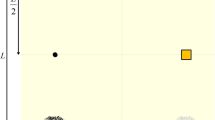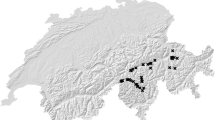Abstract
The impact of different geographical regions (Silesian Foothills, region 1 and Mały Beskids, region 2), and method of soil use (arable field and grassland) on the main soil properties and biological activity was studied. Earthworm biomass, density and diversity, as well as dehydrogenase activity, were analysed. Significant soil physical and chemical properties were more affected by regions, whereas the type of land use had a greater impact on the biological properties. The mean earthworm density was 213 ind. m−2 and 241 ind. m−2 in grassland, and 50 ind. m−2 and 120 ind. m−2 in arable field, in region 1 and 2, respectively. Eight earthworm species were recorded, and fewer species were recorded in arable field (1–4) than in grassland (6–7). The Silesian Foothills are a new habitat for the occurrence of the species Fitzingeria platyura depressa. A high earthworm density was accompanied by high microbial activity, and dehydrogenase activity was lower in the soil of arable field than in grassland soil.
Similar content being viewed by others
References
Blake G.R. & Hartge K.H. 1986. Particle density, Chapter 14. pp. 377–382. DOI: 10.2136/sssabookser5.1.2ed.c14. In: Klute A. (ed.), Methods of Soil Analysis, Part 1. Physical and Miner-alogical Methods. 2nd ed. Series Agronomy, Number 9 (Part 1), SSSA Book Series 5. American Society of Agronomy, Madison, Wisconsin, USA, 118. pp. ISBN-13: 978-0.89118-811-7, ISBN-10: 0-89118.811-8
Bongers T. & Ferris H. 1999. Nematode community structure as a bioindicator in environmental monitoring. Trends Ecol. Evol. 14 (6): 224–228. DOI: doi:10.1016/S0169-5347(98)01583-3
Brito-Vega H., Espinosa-Victoria D., Fragoso C., Mendoza D., De la Cruz Landero N. & AldereteChavez A. 2009. Soil organic matter particle and presence of earthworm under different tillage systems. J. Biol. Sci. 9 (2): 180–183. DOI: 10.3923/jbs.2009.180.183
Brookes P.C. 1995. The use of microbial parameters in monitoring soil pollution by heavy metals. Biol. Fertil. Soils 19 (4): 269–279. DOI: 10.1007/BF00336094
Brzezińska M. & Włodarczyk T. 2006. Methods of soil catalase and dehydrogenase activity measurement, pp. 59–74. In: Russel S., Wyczółkowski A.I. & Bieganowski A. (eds), Selected Methodological Aspects of Soil Enzyme Activity Tests, IA PAS, Lublin. 7. pp. ISBN-10: 8-89969-70-X, ISBN-13: 978-83.89969-70-5
Casida L.E.J., Klein D.A. & Santoro T. 1964. Soil dehydrogenase activity. Soil Sci. 98 (6): 371–376.
Ciarkowska K., Solek-Podwika K. & Wieczorek J. 2014. Enzyme activity as an indicator of soil-rehabilitation processes at a zinc and lead ore mining and processing region. J. Environ. Manage. 132: 250–256. DOI: 10.1016/j.jenvman.2013.10.022
Csuzdi C, Pop V. & Pop A. 2011. The earthworm fauna of the Carpathian Basin with new records and description of three new species (Oligochaeta: Lumbricidae). Zool. Anz. 250 (1): 2–18. DOI: 10.1016/j.jcz.2010.10.001
Curry J.P. 2004. Factors affecting the abundance of earthworms in soils, Chapter 6. pp. 91-113. In: Edwards CA. (ed.), Earthworm Ecology, 2 ed., CRC Press LLC, Boca Raton, 44. pp. ISBN: 0-8493-1819-X
de Vries F.T., Thébault E., Liiri M., Birkhofer K., Tsiafouli M.A., Bjørnlund L., Jørgensen H.B., Brady M.V., Christensen S., de Ruiter P.C., d’Hertefeldt T., Frouz J., Hedlund K., Hemerik L., Hol W.H.G., Hotes S., Mortimer S.R., Setälä H., Sgardelis S.P., Uteseny K., van der Putten W., Wolters V. & Bardgett R.D. 2013. Soil food web properties explain ecosystem services across European land use systems. Proc. Natl. Acad. Sci. USA 110 (35): 14296–14301. DOI: 10.1073/pnas. 1305198110
Dick R.P., Breakwell D.P. & Turco R. F. 1996. Soil enzyme activities and biodiversity measurements as integrative microbiological indicators, Chapter 15. pp. 247–271. DOI: 10.2136/ss-saspecpub49.c15. In: Doran J.W. & Jones A.J. (eds), Methods for Assessing Soil Quality, Soil Science Society of America, Spec. Publ. 49. Madison, Wisconsin, 41. pp. ISBN: 0-89118-826-6
Edwards CA. (ed.) 2004. Earthworm Ecology. CRC Press, Boca Raton, Fl, /456 pp. ISBN: 9780849318191
Edwards CA. & Bohlen P.J. 1996. The Biology and Ecology of Earthworms. Publ. Chapman and Hall, London, 42. pp. ISBN: 0412561603. 9780412561603
Gormsen D., Hedlund K., Korthals G.W., Mortimer S.R., Pižl V., Smilauerova M. & Sugg E. 2004. Management of plant communities on set-aside land and its effects on earthworm communities. Eur. J. Soil Biol. 4 (3-4): 123–128. DOI: 10.1016/j.ejsobi.2004.08.001
Ivask M., Kuu A., Meriste M., Truu J., Truu M. & Vaater V. 2008. Invertebrate communities (Annelida and epigeic fauna) in three types of Estonian cultivated soils. Eur. J. Soil Biol. 4 (5-6): 532–540. DOI: 10.1016/j.ejsobi.2008.09.005
Kasprzak K. 1986. Skaposzczety glebowe III, Rodzina: Dżdżownice (Lumbricidae). Series: Klucze do oznaczania bezkręgowców Polski, tom 6. PAN, Warszawa, 18. pp. ISBN: 8301061677. 9788301061678
Kasprzak K. 1989. Zoogeography and habitat distribution of earthworms (Lumbricidae) and enchytraeids (Enchytraeidae) of the Carpathian Mountains (Poland). Misc. Zool. 13: 37–44.
Kladivko E.J. 2001. Tillage system and soil ecology. Soil Till. Res. 61: 61–76.
Klute A. & Dirksen C. 1986. Water retention. Laboratory methods, Chapter 26. pp. 635-662. DOI: 10.2136/sssabookser5.1.2ed.c26. In: Klute A. (ed.), Methods of Soil Analysis, Part 1. Physical and Mineralogical Methods, 2nd ed., series Agronomy, Number 9 (Part 1), SSSA Book Series 5. American Society of Agronomy, Madison, Wisconsin, USA, 118. pp. ISBN-13: 978-0.89118-811-7, ISBN-10: 0-89118.811-8
Kostecka J. & Skoczeń S. 1993. Earthworm (Oligochaeta: Lumbricidae) populations in four types of beech wood Fagetum carpaticum in the Bieszczady National Park (south-eastern Poland). Part I. Species composition, diversity, dominance, frequency and associations. Acta Zool. Cracov. 36 (1): 1–13. ISBN: 83-900337-8-X
Lee K.E. 1985. Earthworms their Ecology and Relationships With Soils and Land Use. Academic Press, Sydney, 41. pp. ISBN: 0124408605. 9780124408609
Monroy F., Aira M., Dominguez J. & Velando A., 2006. Seasonal population dynamics of Eisenia fetida (Savigny, 1826. (Oligochaeta, Lumbricidae) in the field. Compt. Rend. Biol. 329 (11): 912–915. DOI: 10.1016/j.crvi.2006.08.001
Ouellet G., Lapen D.R., Topp E., Sawada M. & Edwards M. 2008. A heuristic model to predict earthworm biomass in agroe-cosystems based on selected management and soil properties. Appl. Soil Ecol. 39 (1): 35–45. DOI: 10.1016/j.apsoil.2007.11. 003
Paoletti M.G. 1999. The role of earthworms for assessment of sustainability and as bioindicators. Agr. Ecosyst. Environ. 7 (1-3): 137–155. DOI: 10.1016/S0167-8809(99)00034-1
Pelosi C., Pey B., Hedde M., Caro G., Capowiez Y., Guernion M., Peigné J., Piron D., Bertrand M. & Cluzeau D. 2014. Reducing tillage in cultivated fields increases earthworm functional diversity. Appl. Soil Ecol. 83: 79–87. DOI: 10.1016/j.apsoil.2013.10.005
Pižl V. 2002. Žížaly České republiky [Earthworms of the Czech Republic]. Monografické č. seriálu: Sborník přírodovědného klubu v Uherském Hradišti. Supplementum 9. 154 pp. ISBN: 80-86485-04-8
Pižl V. & Stary J. 2001. The effects of mountains meadow management on soil fauna communities (on example of earthworms and oribatid mites). Silva Gabreta 7: 87–96.
Plisko D.J. 1973. Lumbricidae — Dżdżownice (Annelida: Oligochaeta) Fauna Polski - Fauna Poloniae 1. PWN, Warszawa, 15. pp.
Postma-Blaauw M.B., de Goede R.G.M., Bloem J., Faber J.H. & Brussaard L. 2012. Agricultural intensification and deintensification differentially affect taxonomic diversity of predatory mites, earthworms, enchytraeids, nematodes and bacteria. Appl. Soil Ecol. 57: 39–49. DOI: 10.1016/j.apsoil. 2012.02.011
Pulleman M., Creamer R., Hamer U., Helder J., Pelosi C., Pérés G. & Rutgers M. 2012. Soil biodiversity, biological indicators and soil ecosystem services-an overview of European approaches. Curr. Opin. Environ. Sustain. 4 (5): 529–538. DOI: 10.1016/j.cosust.2012.10.009
Römbke J., Jänsch S. & Didden W. 2005. The use of earthworms in ecological soil classification and assessment concepts. Ecotoxicol. Environ. Safe. 62 (2): 249–265. DOI: 10.1016/j.ecoenv.2005.03.027
Rożen A. 1982. The annual cycle in populations of earthworms (Lumbricidae, Oligochaeta) in three types of oak-hornbeam of the Niepolomicka Forest. I. Species composition, dominance, frequency and associations. Pedobiologia 23: 199–208.
European Union’s European Agricultural Fund 2015. The Rural Development Programme (RDP), 2014-2020. [Program Roz-woju Obszarów Wiejskich na lata 201-202. (PROW 2014-2020)] http://www.minrol.gov.pl/ (accessed 26.01.2015).
Schmidt O. 2001. Time limited hand sorting for long-term monitoring of Earthworm populations. Pedobiologia 45 (1): 69–83. DOI: 10.1078/0031-4056-00069
Skiba S. 2008. Some problems of the soil classification of the Carpathian mountain soils. Gruntoznavstvo / Soil Science 9 (3-4): 165–168.
van Eekeren N., Bommele L., Bloem J., Schouten T., Rutgers M., de Goede R., Reheul D. & Brussaard L. 2008. Soil biological quality after 3. years of ley-arable cropping, permanent grassland and permanent arable cropping. Appl. Soil Ecol. 40 (3): 432–446. DOI: 10.1016/j.apsoil.2008.06.010
WRB 2014. World Reference Base for Soil Resources 2014. International soil classification system for naming soils and creating legends for soil maps. Update 2015. In: World Soil Resources Reports 106. FAO, 2014. 192 pp. ISBN: 978-92-5-108369-7
Acknowledgements
The study was supported by the Ministry of Science and Higher Education, Poland, under grant No. N N310 780640.
Author information
Authors and Affiliations
Corresponding author
Rights and permissions
About this article
Cite this article
Józefowska, A., Miechówka, A. & Frouz, J. Comparison of earthworm populations in arable and grassland fields in the Outer Western Carpathians, South Poland. Biologia 71, 316–322 (2016). https://doi.org/10.1515/biolog-2016-0035
Received:
Accepted:
Published:
Issue Date:
DOI: https://doi.org/10.1515/biolog-2016-0035




